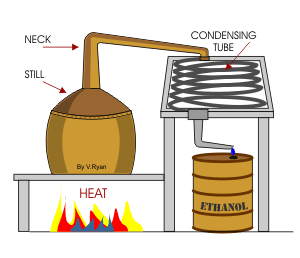distillation
DISTILLATION
Thankfully for our fragile human egos, we can take credit for inventing distillation. This is the process by which intense heat causes the alcohol vapors of a beer- or wine-like base to rise and separate from the water content, then allowed to funnel into a new container as they are cooled from their condensation. The premise of distillation is to gather the alcoholic essence (or “spirit”) of a fermented beverage. What emerges from each distillation is a small alcoholic extraction of its base.
In order to ‘distill’ anything, you would require a ‘still’: a device that can allow heat to be applied to one vessel, then collect the vapors at the top and allow them to dissipate into a separate vessel as they cool. The process of distilling alcohol (or ‘fire water’, as it was known back in the day) was primarily used in medicinal applications. Alcohol is an antiseptic, an anti-bacterial, and a concentrate that can absorb the medicinal quality of any plant that is set inside it. So, for nearly two thousand years, it was produced in modest quantities for practical purposes. In fact, the first known still dates back all the way to India circa 300-500 B.C.! Then the ‘still’ and distillation science made its way from the secret scrolls of alchemists to monasteries to become a common instillation on grain farms - where the excess crop could be thrown into a vat with water for fermentation. Today, distillation is mostly done through a highly sophisticated yet widely available technology called the ‘continuous still’ - a modification of the ‘Coffee Still’ patented by the Irish excisor Aeneas Coffey in 1830, which was based on the ‘column still’, also known as the ‘continuous still’. Basically, the art of distilling is now mostly devoted to producing massive amounts of alcohol as quickly as possible, which is then mostly consumed for pleasure.
Every spirit has two defining characteristics:
1) the base ingredient(s)
and
2) what happens to it after distillation.
[I mean, seriously, what do you do with this thing?]
When a ‘spirit’ emerges from distillation, it is known as ‘the white dog’ - and ‘taming’ it is the objective of the producer.
Commonly, this means either filtration (in the case of vodka) or barrel-aging (in the case of whiskeys, brandy and many añejo rums & tequilas).




![[I mean, seriously, what do you do with this thing?]](https://images.squarespace-cdn.com/content/v1/56874efa0ab377ae44de56c4/1556828566391-FIWQSHIVHZU5KACXRTHY/f6092208d3918d1461b60f118cf68a2b.jpg)